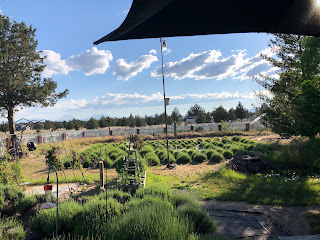July 7, Wool dying
She invited me to stop by on my way to Timothy Lake. Terrebonne is just north of Bend and the shortest route to my next stop. Then she enticed me more, asking if I would like to try my hand at dying fleece. How could I say no to that? She had a basket full of about 4 ounces of fleece all ready for the dye pot when I arrived late in the afternoon.
We sat and enjoyed the warm afternoon on the deck, a delicious dinner of salmon and a green salad before beginning the dye process. After clearing the plates, we gathered large pots, some quart canning jars, and a color selection of dyes and moved to the dye room, which is actually her master bathroom.
We begin by unrolling the balls and submerging them gently into a large pot of tepid water. The wool needs to be completely wet to take up the dye and we don’t want to shock it by having the water too hot or cold. I press it down under the surface of the water without agitating it too, that would cause the fibers to start to cling to each other.
Next is the hardest part for me, picking what color to use. After deliberating over three different blues, I chose the working blue with a bit of aquamarine for one jar and a bright yellow with some orange added in. Then, I lift the fleece out of the pot of water, again handling it gently, and squeeze out some of the water and stuff it into the quart jar. With a chopstick lightly moistened, I dip it into the powder dye and poke it into the fleece in the jar. It doesn’t take very much, maybe 1/8 of a teaspoon.
Making sure to get it sort of evenly around inside the jar, I then fill the jar close to the top, leaving space for a couple of tablespoons of white vinegar. Just like dying Easter eggs, the vinegar sets the dye. I do the same for the second jar, loosely fastening the canning lid, we don’t want to seal it in the hot water bath.
Because we are doing this in the evening, we’re going to use the stove. The second canner pot is on the stove and I place the two jars in the water. She turns on the heat to gradually bring the water to 200 degrees where it stays for 45 minutes. I let her take charge of this part as she knows her stove and this process. If I were doing it during the day, I could just set the jars out in the sun and let them sit all day for the same result.
While we’re waiting, I get another spinning lesson and help with some of the other fleece I had purchased. This was much needed and appreciated. She is so kind, not wanting me to be frustrated with the process, she wants me to be successful and enjoy the process.
When I returned from my early morning hike at Smith Rock it was time to rinse. I opened the first jar, the blue, and the water around the fiber was completely clear which means the fiber took up all the dye. Amazing! I poured out the clear water and gave the wool a quick rinse in clear tepid water. Then I did the same with the yellow jar and gently squeezed out most of the water. Both batches went into mesh bags for a quick spin in the washing machine to get out the rest of the water.
Onto the drying rack out in the warm sun on the deck. Of course through the spin cycle, some of the fiber starts to stick to itself and we work together to straighten out and fluff it as it drys. It doesn’t take long and we set it aside to get completely dry before the last step.
She says it doesn’t always need to be carded again, but she wants it to be easy for me to work with. While I am reassembling my now dry bedding, she has taken the dry wool and run it through her drum carder and brings it out in the basket it started in, but now in these brilliant colors waiting for me to spin it into yarn.











How fun!!!
ReplyDeleteThis experience/adventure says so much about the natural unfolding of your solo journey. Meeting a stranger, a woman, at the lighthouse. You and she sharing your love of wool, spinning and then, the dyeing! Harmony
ReplyDelete